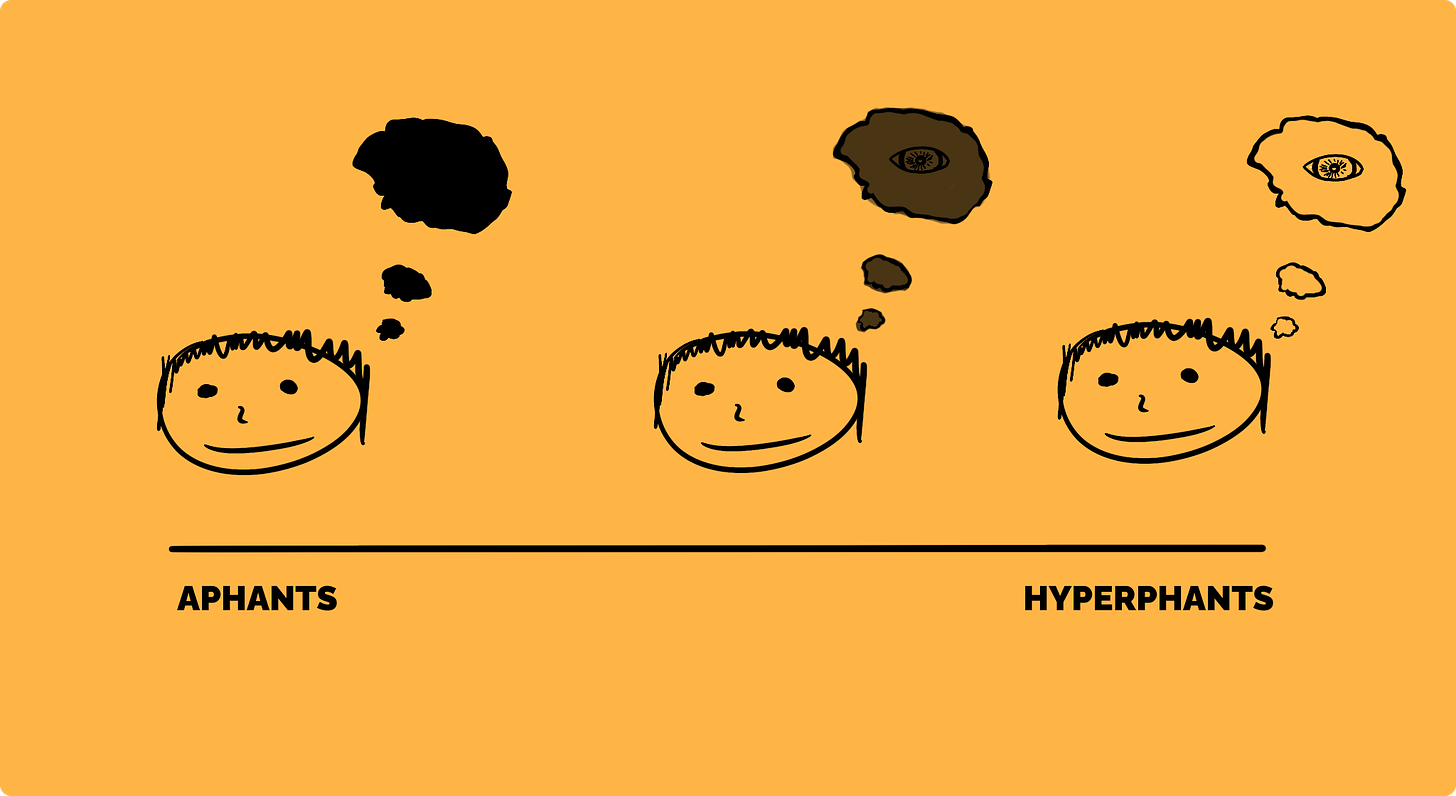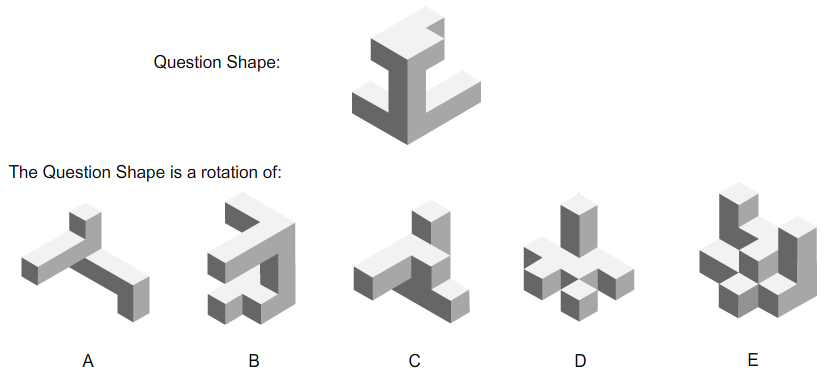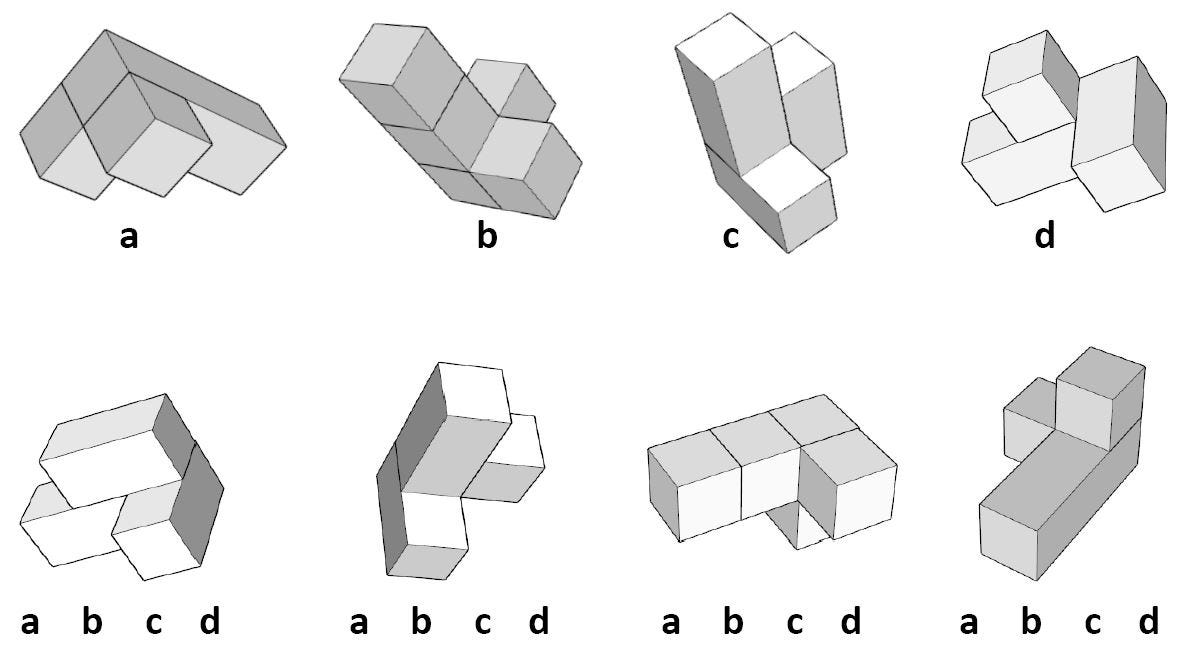(1/2) Mind’s Eye: Powers
Can you see your inner world? How vast and vivid is is it? If you have a mind’s eye, then this post might let you in on some superpowers you didn’t even know you had.
Intro
Hey super humans!
How vast and vivid is your inner world? Because if you have a mind’s eye, then this post might let you in on some unique abilities you didn’t even know you had.
Differences in our ability to visualize images in our mind have been known for a while, but it was only in 2015, when the word aphantasia made its way into existence and went mainstream. Dividing the world into those with a mind’s eye, who have the ability to think in images and those with a mind’s eye patch, who’s imaginations become dark once their eyes are closed.
For centuries we lived in blissful ignorance of each other’s realities. But now that our differences have been exposed, a lot of us have a growing curiosity about what everyone else’s minds are capable of. And some of us are even starting to wonder, “what is it that my mind is uniquely capable of?”
Defining Mind’s Eye
Mind’s Eye Scale
Assuming that the mind’s eye isn’t binary, where you either have it or you don’t, then there’s likely a spectrum of mind’s eye ability, where some people’s are stronger than others. Any idea where you’d land on the scale?
Based on surveys today, there are an estimated 0.7% of people who would be classified as aphants — the ones whose mind’s eyes are completely blind. Then as you move down the spectrum you have people who’s mental visualizations become more and more powerful. Until we finally hit the other end, where there’s an estimated 2.6% of people who’s mind’s eyes are so powerful that they would be classified as having hyperphantasia.
Mind’s Eye Definition Difficulty
So what exactly is a mind’s eye? It may seem like an obvious question to those of us who can visualize easily, but I’d imagine that people with blurrier visualizations might start to question “am I really experiencing the same mind’s eye that everyone else is talking about?” Because, barring any of you mind reading mutants out there, no one can know exactly what goes on inside of another person’s imagination. We can’t know for certain that my experience with my mind’s eye is the exact same as yours. But, while we can’t know another person’s experience, we can, through conversation, discover how it differs from our own.
It’s my understanding that many people with a mind’s eye patch are still able to experience vivid dreams. So, generally speaking, if we were to try to explain the experience of a mind’s eye in a way for most people to understand, maybe we could describe it as a lucid daydream.
Mind’s Eye Features
But if we were to dig a little deeper, the 4 features which help to clarify its meaning for me are that:
it is not rationalization,
it is not memory,
it is an emotional amplifier,
and, most importantly, its power extends far beyond a single spectrum of image clarity.
Rationalization vs Instinct
Can you solve this spatial orientation puzzle?
How’d you do it? If you’re like me, then you probably used your mind’s eye to actively visualize the object rotating. And to my surprise, as someone who relies on his mind’s eye a lot, there are aphants who can totally thrive at puzzles like this and other mental-based spatial tasks. They simply use other methods to conceptualize and rationalize their way to a solution.
It seems to me that depending on where you land on the scale, there is a balance between instinct and rationalization. Learning that helped me realize the struggle that some people on the mind’s eye patch side of the scale might experience when trying to figure out if they have a minds eye. “I can kinda see something, but maybe I’m actually just rationalizing and deceiving myself into believing that I’m seeing something.”
Other Senses Example
Perhaps you can relate to that confusion if you consider the other mind senses that exist. In my case, I feel like I have a really vivid mind’s eye and mind’s ear, but if you were to ask me to imagine the taste or the smell of popcorn for example, my natural instinct is to picture myself holding a bag of it and taking a whiff. The smell feels almost accessible, but also just out of reach. I can rationalize that it’s buttery and salty, but because those mind senses are nowhere as close to as potent as my mind’s eye or ear, I can tell that I’m relying on a rational process to fill in the blanks. I think that attempting to distinguish between these two processes could be a helpful way to figure out where we as individuals might land on these different mind sensory scales.
Memory vs Mind’s Eye
If you’re trying to figure out where you might land on the scale, I think that another important consideration would be to recognize that memory and the mind’s eye are two separate abilities. There is evidence that these two processes are connected (people with stronger mind’s eyes have been shown to have an easier time with episodic memory and recalling events from their life, for example). But while these processes go hand-in-hand, they are not one in the same.
Box of Objects Example
If I was to ask you to take a look at a box of objects, close your eyes, and then describe to me each of the items. You might have a hard time coming up with a clear picture and start to question the capability of your mind’s eye. But if I was to instead ask you to close your eyes, imagine a random box with a few items in it, and then describe that to me. You might not struggle as much. Our memory is only as good as how much attention we pay. So if you struggle to conjure up a detailed mental image of a saxophone, then perhaps that is more evident of the fact that you never paid much attention to saxophones, rather than the strength of your mind’s eye.
Mental Imagery Types
I think it’s also important to acknowledge that not all mental imagery comes equally to all of us. Some people, for example, claim to be able to conjure words more easily than images. In my case, I’m not sure why, but I have a hard time imagining the faces and voices of people close to me. But if you were to ask me to visualize the face of any actor I’ve seen in a tv show, I’d have no problem.
Emotional Amplification
Studies suggest that the mind’s eye can act as an emotional amplifier, so perhaps another way to assess the strength of our mind’s eye could be to question how visual imagery in books and writings affects us.
I remember the time that I was reading Gerald’s Game by Stephen King. I was sitting alone on a bus coming home from university; nose deep in my book. The plot was getting intense and I was gripping the pages roughly in eager anticipation. That was until my body went limp. I felt the blood drain from my extremities and rush to my head. My hands could no longer form a fist and my book fell to my lap. And why? Because the story did too well of a job painting the picture of a gory scene in my mind and seeing all of its bloody details made me feel faint. To me, that feels like an experience that I couldn’t have had without mental imagery, but I do wonder if it would be possible for someone to rationalize their way to a similar state.
Mind’s Eye Powers
Finally, I would argue that our mind’s eye is much more than a single spectrum of clarity. That clarity is just one of several powers that we all have to different degrees. And that you or I might even be hyperphants — people with superior control of one of these other spectrums. So which of the following powers that I’m about to describe are you a natural at?
Based on what I’ve been able to devise from my own mind’s eye abilities, I’d say we have 6 core mental imagery powers: conjuring, transmutation, orientation, astral projection, playback, and double vision.
Conjuring | Image Generation
Conjuring is the ability to generate images in our mind with accuracy. It’s what I’d imagine most people think of when they hear mind’s eye. What happens if I ask you to close your eyes and imagine this green balloon floating in front of you?
Can you see it? People with powerful conjuring abilities would probably describe their imaginations as vivid and would have little to no problem replicating that green balloon in their minds.
And, based off of self-reported limitations that I’ve heard people describe about their own experiences, perhaps there’s an element of duration that can be included in this power, where the ability to maintain that image for as long as we want is an offshoot of this power that we all have to varying degrees.
Transmutation | Trait Manipulation
Transmutation is the ability to manipulate traits. I like to think of it as the augmented reality of a mind’s eye, where we have the ability to look at the world through a lens or a filter of our choosing. For example, people with powerful transmutation abilities probably wouldn’t have much of a problem taking that green balloon and imagining it red.
Orientation | Space manipulation
Orientation is the ability to manipulate space. It’s the telekinesis of our mind’s eye that allows us to move objects within our imagination. People with powerful orientation powers would be great at spatial orientation puzzles like these:
They also likely wouldn’t have any difficulty shifting their perspective upward while imagining that red balloon floating into the air above them.
Astral Projection | Mind-Body Detachment
Astral projection is the ability to detach our mind from our body. It’s kinda like being able to teleport our perspective. If I were to ask you to imagine yourself inside of that red balloon, could you do it? Powerful astral projection skills would allow a person to imagine seeing the world from any vantage point.
Playback | Recording Reproduction
Playback is the ability to reproduce and manipulate mental recordings. It serves as the video controller of our imagination. People with powerful playback abilities can push play on their imagination and create active scenes. They likely have an easy time replaying memories from their past and might even be able to rerun their favourite scenes from movies and shows.
Double Vision | Eyes Open
And finally, double vision is the ability to use our mind’s eye while our body’s eyes are open. Along with conjuring, It would be the active power if I were to ask you to imagine the room you’re sitting in filled with balloons.
Conclusion
On their own, each of these 6 abilities enable us to bend reality to our will. And a lot of clever people have learned to harness and even combine these powers in order to perform impressive feats.
Can you conjure up an image of the home you grew up in as a kid? Can you astral project yourself into your old bedroom and walk to your bathroom? If you can, then you might have what it takes to become a memory champion.
Memory athletes often use astral projection alongside conjuring in order to perform the method of loci — a strategy used to teleport their perspective into an imagined recreation of a place from their past. A place that they can use to store and organize information, that would otherwise have been floating around inaccessibly in the abyss of their mind space.
The top memory athletes in the world have been able to recall the order of over 2000 shuffled playing cards. And most, if not all of them, were able to accomplish that by training these 6 powers in order to enhance their mind’s eye. And with a little bit of creative thinking, maybe we can train and hone our powers as well.
So what do you think? Do you agree with my superpowers? Which powers do you have that I didn’t consider. In my next post I’m going to put our visual imaginations to the test with 13 games that’ll test the limits of our mind’s eye.
P.S.
The answer to Puzzle 1 is B.
And the answers to the bottom row of Puzzle 2 are C, D, B, A.







